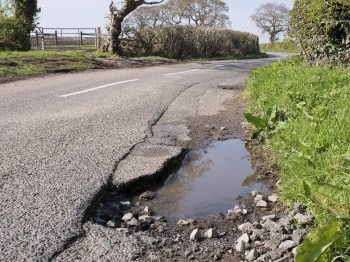‘Odds stacked against road users’ for pothole damage, says AA
Breakdowns due to pothole damage are at near record levels as springtime road repairs fail to dent the UK’s ‘plague of potholes’.

More two-wheeled riders are at risk from potholes as the weather improves
The Government pledged an extra £200m for pothole repairs in the Spring Budget, but latest AA figures show that breakdowns due to pothole damage dropped by a mere 4% in May compared to the previous month.
Its patrols attended nearly 50,000 pothole-related incidents in May; more than 1,600 a day. It’s the second highest number of breakdowns caused by potholes recorded by the index since it started in 2017.
Local authorities are now starting to get to grip with the plague of road damage caused by winter and patchy maintenance over many years. And the AA says that actually being able to see potholes on the road will become easier as we enter the summer and drier conditions.
But the warmer weather also means there will be higher numbers of motorcyclists and cyclists on the roads, who are more at risk from potholes as they try to dodge and swerve the ruts and cracks.
Jack Cousens, head of roads policy for the AA, said: “Such has been extent of damage to UK roads, caused by winter’s ravages and poor road maintenance over many years, that the May bank holiday road travellers ran the risk of major damage and repair bills – particularly if they ventured off the main roads into the country.
“The big concern is the extra risk posed for the increased number of cyclists and bikers on to the road. Yes, the drier weather might have made the potholes easier to spot, but the sheer number of potholes means the odds are stacked against road users.”
Councils spend less on protecting roads
New figures indicate why the UK may be facing further crumbling roads, as councils spend less to protect roads in the first place and more on filling them after potholes appear.
Sales information supplied by the Road Emulsion Association (REA) and the Road and Surface Treatments Association (RSTA) to The Telegraph reveals councils have drastically cut back on ‘surface dressing’. This uses bitumen and aggregate to provide a cost-effective way of restoring road surfaces, increasing the lifespan of roads by around 15 years.
But declining investment by councils in surface sharing materials saw the number of square miles of road able to be protected drop by 42% from 2012 to 2022.
Kevin Amos, chairman of the REA, told The Telegraph: “The decline in surface dressing over the past decade has coincided with the number and cost of potholes rising significantly.”
Investing more on protecting roads could have drastically reduced the £1bn+ spent by councils on filling potholes over the last decade.
Amos added: “If the industry can reverse this decline in surface treatments such as surface dressing, then we can stop potholes forming in the first place and keep roads in better condition for longer.”












